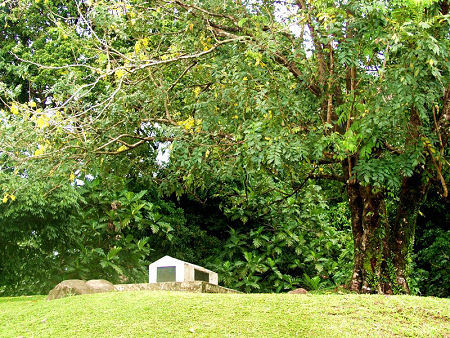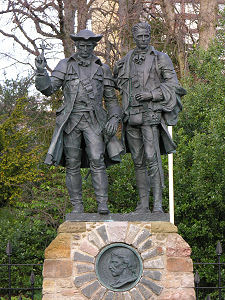 Robert Louis Stevenson's grave on Mt Vaea, Samoa Note About Image Copyright |
Robert Louis Stevenson, who lived from 13 November 1850 to 3 December 1894, was a renowned essayist, poet, and author of fiction and travel books. He is best known for his adventure novels like Treasure Island (1883)and Kidnapped (1886), though many view his most important and influential work to have been The Strange Case of Dr Jekyll and Mr Hyde (1886). The wider picture in Scotland at the time is set out in our Historical Timeline.
Robert Lewis Balfour Stevenson was born in Edinburgh on 3 November 1850. His father was Thomas Stevenson his grandfather Robert Stevenson, both members of the "Lighthouse Stevensons" the family who between them were responsible for building most of Scotland's lighthouses (and many more beyond these shores).
As a child, Stevenson suffered from tuberculosis. At the age of 18 he dropped "Balfour" from his name and changed the spelling of "Lewis" to "Louis". From about the same time he began to refer to himself as RLS.
Despite the fragility of his health, RLS's family hoped that he would follow his father and become a lighthouse engineer. He duly entered Edinburgh University to study engineering, but his heart was never in it. He therefore changed to studying law and, following his graduation, he was called to the Bar in 1875. By then he had already begun to have articles published in various journals.
RLS travelled extensively in an effort to find a climate that helped his lungs. His first book, An Inland Voyage, was an account of a journey through Belguim and France in a canoe designed by John MacGregor. While travelling in France he met Fanny Vandegrift Osbourne, a married woman ten years older than himself with two children. She returned to California to get a divorce, and in 1879 RLS followed her. They married in 1880. RLS said that the idea for his first major novel, Treasure Island, came to him while walking along a Californian beach with Fanny.
For lovers of Scotland RLS's masterpiece has to be Kidnapped, published in 1886. The core of this is a flight across Scotland from the tip of Mull to Edinburgh, pursued by Government troops in the aftermath of the 1745 Jacobite uprising. He followed it up with a sequel, Catriona, in 1893.
His biggest contemporary hit was probably The Strange Case of Dr Jekyll and Mr Hyde. This was published in January 1886, and 40,000 copies had been sold by June.
From the late 1880s, following a number of visits to Hawaii, Stevenson was increasingly living in the South Pacific with his family on an estate he had purchased in Vailima, Samoa. The servants on the estate called him Tusitala or "Teller of Tales". During this period he wrote the novel The Wrong Box with his stepson Lloyd Osbourne.
Fanny suffered a mental breakdown in 1893. And on 3 December 1894 Stevenson died of a brain haemorrhage at the family home in Samoa. He was just 44 years old and according to many he was approaching the height of his powers as an author. He left unfinished what many consider his greatest work, Weir of Hermiston.
RLS's grave on Mt Vaea, Samoa carries the following quotation from his Old Mortality, published in 1884: Here he lies where he longed to be; home is the sailor, home from sea, and the hunter home from the hill.
You can read the full text of Edinburgh: Picturesque Notes by Robert Louis Stevenson online on Undiscovered Scotland. Part guide book, part social commentary, this book gives a fascinating insight into Auld Reekie: the Edinburgh of another era. You can also read the full texts of Kidnapped and Catriona.

